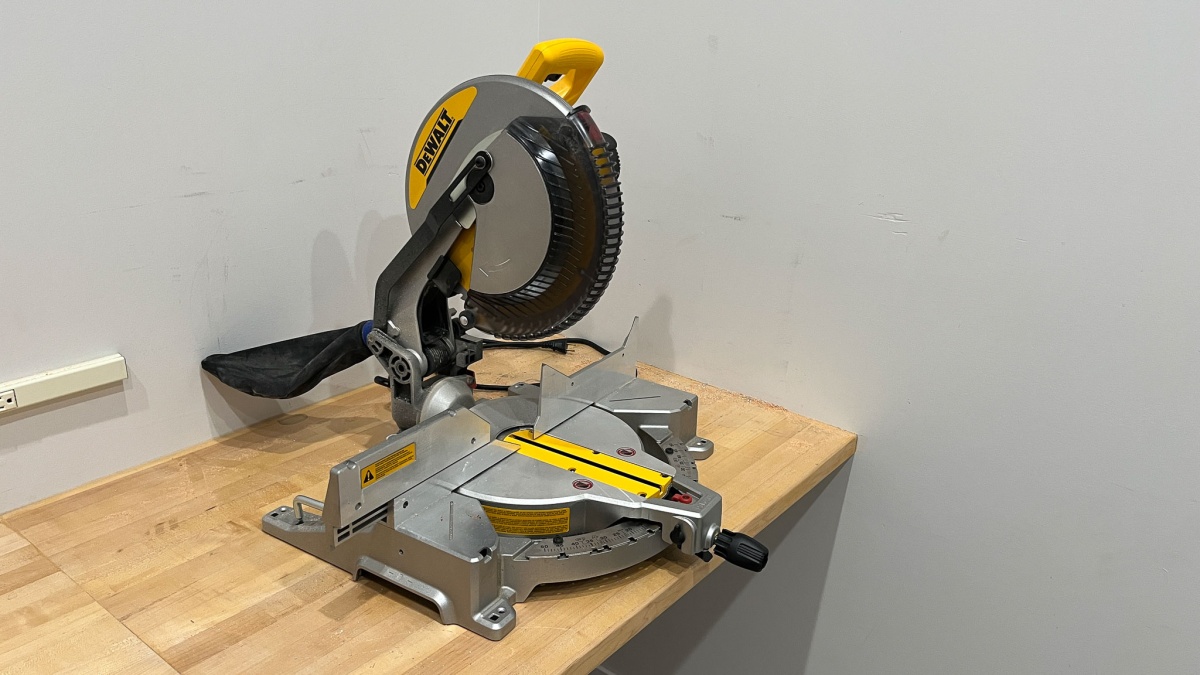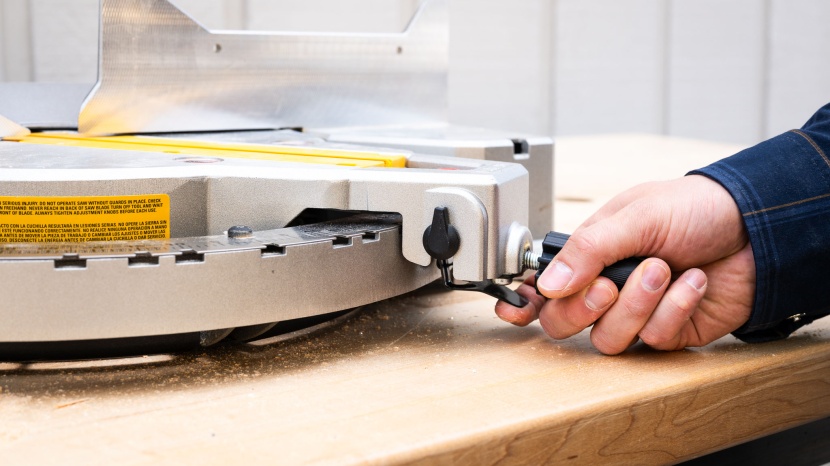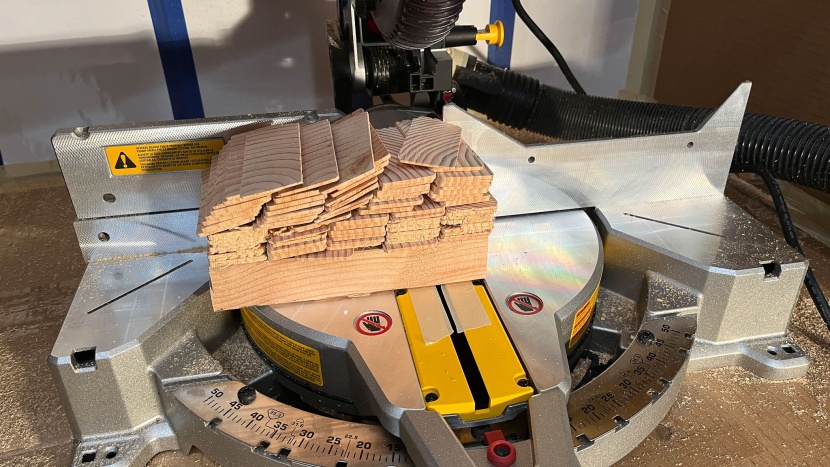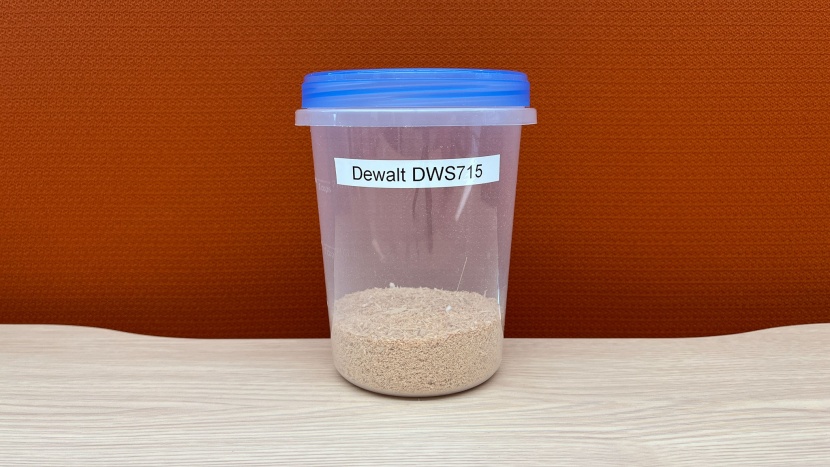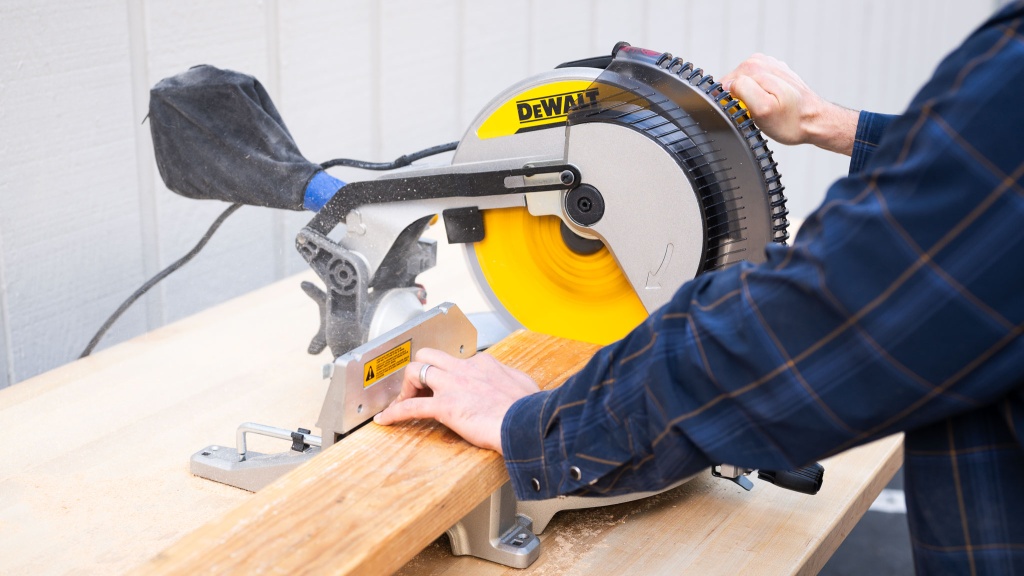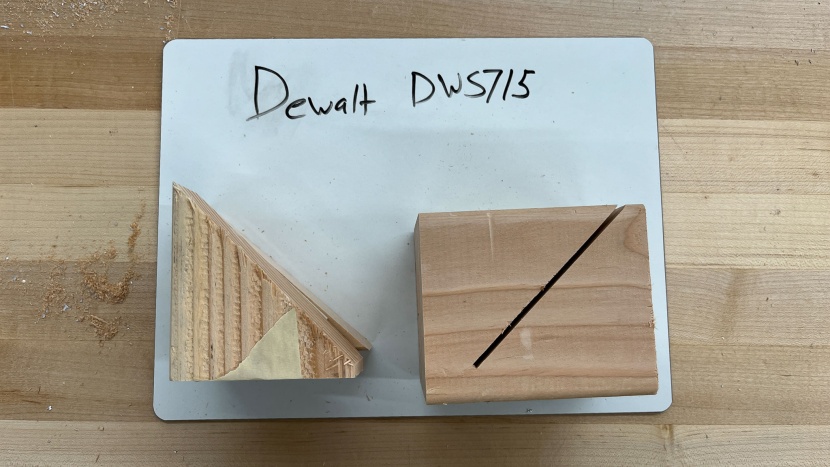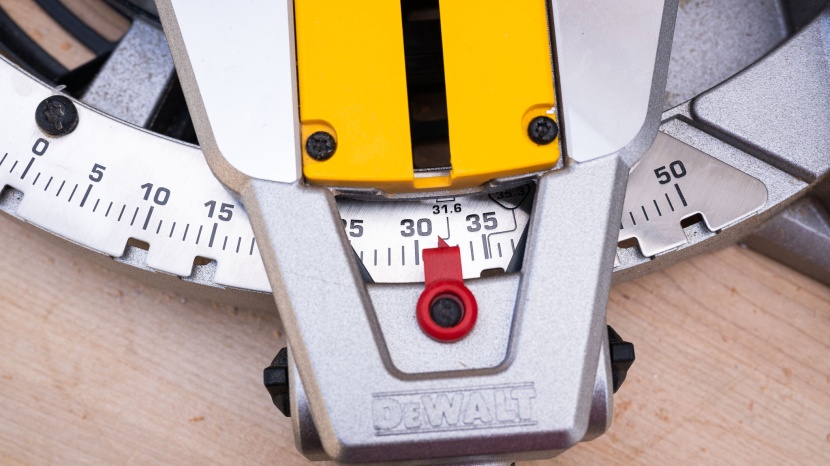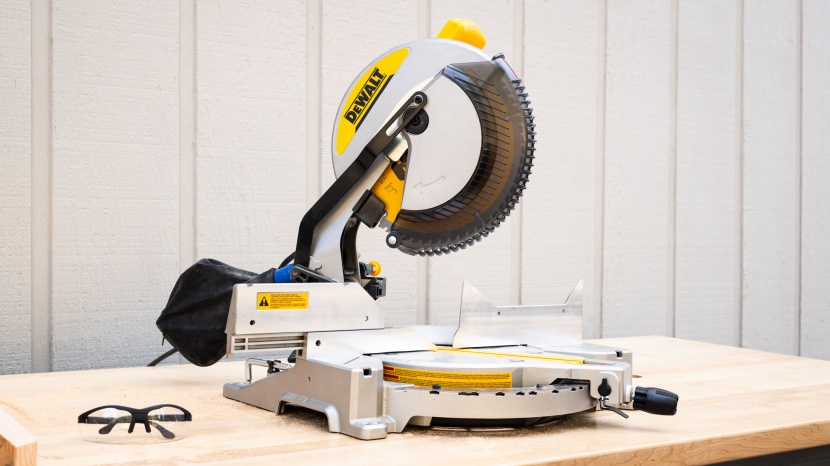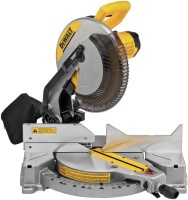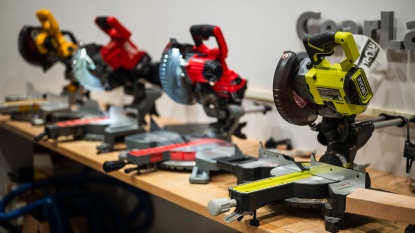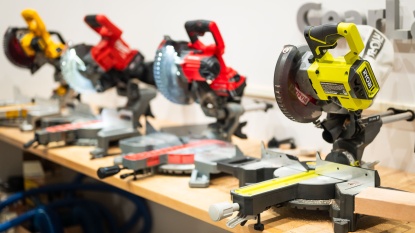
Our Verdict
Our Analysis and Test Results
The DeWalt 12-inch Single Bevel Compound Miter Saw DWS715 is a reliable and robust choice for professionals and DIY enthusiasts looking for precision and power. That said, it has a modest cut capacity due to the lack of a sliding rail.
Ease of Use
When it comes to power tools, ease of use is often as important as the raw power the tool possesses. Our evaluation crew carefully fine-tuned, set up, and examined the intricate aspects of the saws, focusing on the nuances of the blade replacement mechanism, calibration, and cut line indicators. The DeWalt DWS715 shines in this regard, offering an impressive user experience with several features designed to streamline the process.
The calibration of a new saw is critical before your first project. The DeWalt is straightforward to calibrate for both the bevel and miter angle cuts. Fortunately, it arrived and required less calibration than its competitors.
.
For normal use, the miter adjustments are straightforward, utilizing a typical screw miter lock mechanism that is familiar and reliable. The blade change process is particularly noteworthy and one of our testers' favorite systems. It's user-friendly, and the blade guard will lock in place to provide clear and easy access to change the blade. The blade lock button is comfortable to press.
The saw boasts 14 positive miter stops at various angles from 0 to 50 degrees and four positive bevel stops at crucial angles, which is more than adequate for most cutting jobs. The miter lock override is stiff, which may require a firmer grip and a bit more effort to engage. Still, it's a minor inconvenience when considering the stability and precision it provides. The 50-degree miter angle is another feature that adds to the flexibility of the saw, allowing users to make cuts beyond the 45-degree mark. However, the lack of a cut line indicator can take longer to line up cuts and leaves a larger margin for error.
The saw can make up to 45-degree bevel cuts. However, it has no positive stops that click into place and maintain the angle. Selecting and maintaining the angle requires the user to be accurate across each cut.
Despite this, the compact nature of the non-sliding saw allows it to be placed closer to a wall, saving valuable workspace—a significant advantage in smaller workshops or job sites.
Dust Collection
A capable dust management setup is highly beneficial for hobbyists tackling projects in limited areas or tradespeople on location. It significantly lessens the time spent on post-work tidying and increases the overall efficiency. We constructed a compact chamber to trap sawdust and executed 100 cuts on a 2x4 to evaluate this attribute. We employed a vacuum attached to the hose adapter during this process to assess its effectiveness. Subsequently, we collected and quantified the remaining sawdust near the saw to determine its dust collection efficiency. The DeWalt DWS715 helped keep our shop clean with its effective saw dust collection.
Like every saw in this review, the dust collection bag was far less effective than attaching a vacuum. When connected to a vacuum, the saw's dust collection capabilities improve significantly.
Surprisingly, without a dust curtain, the saw left less residual dust than expected. After our 100 cuts, we swept up only 1.17 ounces of sawdust, making it one of the better options for this review.
Cut Capacity
The cutting capabilities of a miter saw are pivotal, as they directly influence whether the tool is appropriate for the specific demands of your projects. We conducted thorough testing on each saw to ascertain its proficiency in managing sizeable pieces of wood for various types of cuts, including bevel, miter, and crosscuts. The non-sliding nature of the DeWalt DWS715 means its cut capacity is less than other sliding models, but its larger blade size helps improve the overall capacity.
The DeWalt DWS715 offers a cut capacity sufficient for handling standard lumber sizes used in many projects. This tool can make a crosscut on a 2x8, which covers a substantial range of common applications. It is also equipped to perform 45-degree miter cuts through a 2x6, which should satisfy the requirements for most flooring or trim projects.
For vertical cuts, the DWS715 provides decent capacity. It can cut through the thickness of a 4x4 without significant difficulty. In our tests, the saw made clean 90-degree cuts with a depth of up to 4-5/32 inches. It also performed well when making a 45-degree bevel cut through a 2x4 and could handle cutting across a 4x4 at a depth of 3-15/16 inches.
These results suggest that the DWS715 is a capable tool for various cutting tasks as it covers most basic carpentry and framing needs without issue.
Cutting Power and Speed
Progress can be significantly impeded by a saw blade that falters or stops during a cut because of inadequate power in relation to the speed of the cut. This issue can cause setbacks and cuts that don't meet quality standards. In our evaluation, we put the saws to the test by slicing through a 2-inch aluminum angle bracket with the apex oriented upwards, thus presenting a more demanding challenge by requiring the blade to cut through both flanges of the bracket. We also made consecutive cuts into 4x4 lumber to assess performance under typical conditions. To supplement our analysis, we measured each saw's rotations per minute (RPM) using a tachometer. Although these RPM figures did not directly influence the final score, they provided additional insights into the potential of each saw. The DeWalt DWS715 doesn't disappoint when it comes to cutting power and speed.
With an impressive 3990 RPM, it slices through materials with ease. Our tests showed that when cutting through a 4x4 piece of lumber, the saw performed effortlessly without noticeable or auditory strain on the motor. We could hear a slight strain in the motor when we performed two consecutive rapid cuts, but the saw easily powered through.
When cutting aluminum, the saw made quick work of the material. It was able to cut through the material at a faster pace than other saws within the review. Our test team had to double-take to ensure the material was there. The DSW715 is one of the most powerful tools we tested and is up to most tasks appropriate for a miter saw.
Precision and Accuracy
Accuracy is paramount for miter saws. These tools are designed for rapid and intricate cuts. Our test team focused on the precision and degree accuracy of the miter, bevel, and crosscut by measuring each relevant angle before and after testing. The Dewalt is a precise and accurate tool as it displayed close to spot-on calibrations out of the box and minimal drift throughout our testing process.
The DWS715 came ready to use out of the box and required little to no calibration due to the precise assembly. The saw blade was 90 degrees to the table, and the 45-degree bevel was spot on at 45 degrees.
After testing, the saw blade remained square to the table and only drifted .1 degrees, and the 45-degree bevel angle remained unchanged. Most T-bevels, a tool to measure angles, have a margin of error of .3 degrees. The table is flat and square, which contributes to consistent quality cuts.This tool's precision and accuracy make it a great choice for heavy use as it maintains its calibration for longer than other miters saws on the market.
Should You Buy the DeWalt DWS715?
If you're in the market for a non-sliding miter saw that offers impressive power and maintains its calibration for accurate cuts, the DeWalt DWS715 should be at the top of your list. If you need a larger cut capacity or prefer a cut line indicator, other models will likely better fit your desires.
What Other Saws Should You Consider?
For those seeking greater cut capacity without compromising precision or usability, the DeWalt DWS780 12-Inch Double Bevel Sliding Compound Miter Saw is worthy of your attention. Designed to deliver flawless cross cuts through 2x12 lumber while providing similar precision as the DWS715. Alternatively, if you prefer a compact yet robust design, consider the Ryobi 18V ONE+ 7-1/4-Inch Single Bevel Sliding Compound PBT01B. Its strong cut capacity makes cross cuts through 2x10 lumber, and its lightweight frame of merely 24 pounds 14 ounces, including the battery, makes it a highly portable and capable model.
| Awards | Best Non-Sliding Saw |
|---|---|
| Price | $359 List Check Amazon (on sale!) |
Overall Score  |
|
| Star Rating | |
| Bottom Line | This non-sliding model offers substantial power, impressive build quality, and dust management, though it has less cut capacity and no positive stops for beveled cuts |
| Pros | Easy blade change, easy adjustments, build quality, powerful |
| Cons | Small horizontal cut capacity, no bevel stops between 0 and 45 |
| Rating Categories | DeWalt 12-Inch Singl... |
| Ease of Use (45%) | |
| Dust Collection (20%) | |
| Cut Capacity (15%) | |
| Cutting Power and Speed (15%) | |
| Precision and Accuracy (5%) | |
| Specifications | DeWalt 12-Inch Singl... |
| Cut Line Indicator | None |
| Measured Weight | 37.31 lbs |
| Measured dust collection after 100 cuts | 1.17 oz |
| Max Measured Cut Depth at 90 | 8.1 in |
| Blade Diameter | 12" |
| Positive Stops Miter | (14) 45º, 35.3º, 31.6º, 22.5º, 15º, 10º, 0º, 10º, 15º, 22.5º, 31.6º, 35.3º, 45º, 50º |
| Positive Stops Bevel / Tilt | (4) 48º*, 45º, 0º, 3º* |
| Blade Cut Depth Stop | No |
| Sliding | No |
| Bevel | Single |
| Miter Angle Range | 47° Left 47° Right |
| Bevel Angle Range | 48° Left 3° Right |
| Measured RPM | 3990 |
| Average Measured Blade Runout Time | 2.25 seconds |
| Measured Table Width | 21-5/8" |
| Measured Table Width with Extensions | No Extensions |


